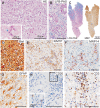Diagnostic red flags: steroid-treated malignant CNS lymphoma mimicking autoimmune inflammatory demyelination
- PMID: 28213912
- PMCID: PMC8028373
- DOI: 10.1111/bpa.12496
Diagnostic red flags: steroid-treated malignant CNS lymphoma mimicking autoimmune inflammatory demyelination
Abstract
The presence of inflammation and demyelination in a central nervous system (CNS) biopsy points towards a limited, yet heterogeneous group of pathologies, of which multiple sclerosis (MS) represents one of the principal considerations. Inflammatory demyelination has also been reported in patients with clinically suspected primary central nervous system lymphoma (PCNSL), especially when steroids had been administered prior to biopsy acquisition. The histopathological changes induced by corticosteroid treatment can range from mild reduction to complete disappearance of lymphoma cells. It has been proposed that in the absence of neoplastic B cells, these biopsies are indistinguishable from MS, yet despite the clinical relevance, no histological studies have specifically compared the two entities. In this work, we analyzed CNS biopsies from eight patients with inflammatory demyelination in whom PCNSL was later histologically confirmed, and compared them with nine well defined early active multiple sclerosis lesions. In the patients with steroid-treated PCNSL (ST-PCNSL) the interval between first and second biopsy ranged from 3 to 32 weeks; all of the patients had received corticosteroids before the first, but not the second biopsy. ST-PCNSL patients were older than MS patients (mean age: ST-PCNSL: 62 ± 4 years, MS: 30 ± 2 years), and histological analysis revealed numerous apoptoses, patchy and incomplete rather than confluent and complete demyelination and a fuzzy lesion edge. The loss of Luxol fast blue histochemistry was more profound than that of myelin proteins in immunohistochemistry, and T cell infiltration in ST-PCNSL exceeded that in MS by around fivefold (P = 0.005). Our data indicate that in the presence of extensive inflammation and incomplete, inhomogeneous demyelination, the neuropathologist should refrain from primarily considering autoimmune inflammatory demyelination and, even in the absence of lymphoma cells, instigate close clinical follow-up of the patient to detect recurrent lymphoma.
Keywords: corticosteroids; demyelination; diffuse large B cell lymphoma; inflammation; multiple sclerosis.
© 2017 International Society of Neuropathology.
Conflict of interest statement
The authors do not report any conflict of interest.
Figures



References
-
- Brück W, Brunn A, Klapper W, Kuhlmann T, Metz I, Paulus W, Deckert M (2013) Differenzialdiagnose lymphoider Infiltrate im Zentralnervensystem. Der Pathologe 34:186–197. - PubMed
-
- Brück W, Porada P, Poser S, Rieckmann P, Hanefeld F, Kretzschmarch HA, Lassmann H (1995) Monocyte/macrophage differentiation in early multiple sclerosis lesions. Ann Neurol 38:788–796. - PubMed
Publication types
MeSH terms
Substances
LinkOut - more resources
Full Text Sources
Other Literature Sources
Medical

